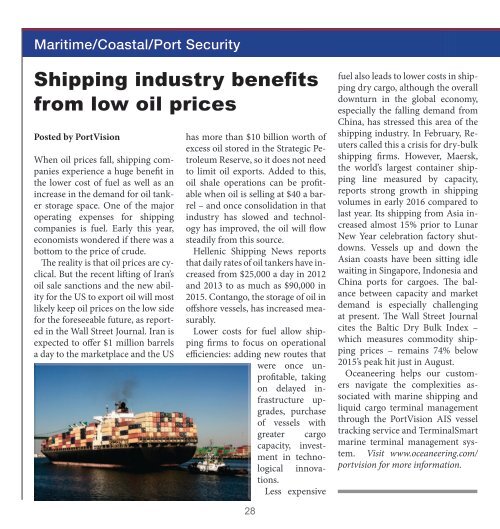GSN Digital Edition April 2016
You also want an ePaper? Increase the reach of your titles
YUMPU automatically turns print PDFs into web optimized ePapers that Google loves.
Maritime/Coastal/Port Security<br />
Shipping industry benefits<br />
from low oil prices<br />
Posted by PortVision<br />
When oil prices fall, shipping companies<br />
experience a huge benefit in<br />
the lower cost of fuel as well as an<br />
increase in the demand for oil tanker<br />
storage space. One of the major<br />
operating expenses for shipping<br />
companies is fuel. Early this year,<br />
economists wondered if there was a<br />
bottom to the price of crude.<br />
The reality is that oil prices are cyclical.<br />
But the recent lifting of Iran’s<br />
oil sale sanctions and the new ability<br />
for the US to export oil will most<br />
likely keep oil prices on the low side<br />
for the foreseeable future, as reported<br />
in the Wall Street Journal. Iran is<br />
expected to offer $1 million barrels<br />
a day to the marketplace and the US<br />
has more than $10 billion worth of<br />
excess oil stored in the Strategic Petroleum<br />
Reserve, so it does not need<br />
to limit oil exports. Added to this,<br />
oil shale operations can be profitable<br />
when oil is selling at $40 a barrel<br />
– and once consolidation in that<br />
industry has slowed and technology<br />
has improved, the oil will flow<br />
steadily from this source.<br />
Hellenic Shipping News reports<br />
that daily rates of oil tankers have increased<br />
from $25,000 a day in 2012<br />
and 2013 to as much as $90,000 in<br />
2015. Contango, the storage of oil in<br />
offshore vessels, has increased measurably.<br />
Lower costs for fuel allow shipping<br />
firms to focus on operational<br />
efficiencies: adding new routes that<br />
were once unprofitable,<br />
taking<br />
on delayed infrastructure<br />
upgrades,<br />
purchase<br />
of vessels with<br />
greater cargo<br />
capacity, investment<br />
in technological<br />
innovations.<br />
Less expensive<br />
fuel also leads to lower costs in shipping<br />
dry cargo, although the overall<br />
downturn in the global economy,<br />
especially the falling demand from<br />
China, has stressed this area of the<br />
shipping industry. In February, Reuters<br />
called this a crisis for dry-bulk<br />
shipping firms. However, Maersk,<br />
the world’s largest container shipping<br />
line measured by capacity,<br />
reports strong growth in shipping<br />
volumes in early <strong>2016</strong> compared to<br />
last year. Its shipping from Asia increased<br />
almost 15% prior to Lunar<br />
New Year celebration factory shutdowns.<br />
Vessels up and down the<br />
Asian coasts have been sitting idle<br />
waiting in Singapore, Indonesia and<br />
China ports for cargoes. The balance<br />
between capacity and market<br />
demand is especially challenging<br />
at present. The Wall Street Journal<br />
cites the Baltic Dry Bulk Index –<br />
which measures commodity shipping<br />
prices – remains 74% below<br />
2015’s peak hit just in August.<br />
Oceaneering helps our customers<br />
navigate the complexities associated<br />
with marine shipping and<br />
liquid cargo terminal management<br />
through the PortVision AIS vessel<br />
tracking service and TerminalSmart<br />
marine terminal management system.<br />
Visit www.oceaneering.com/<br />
portvision for more information.<br />
28
















